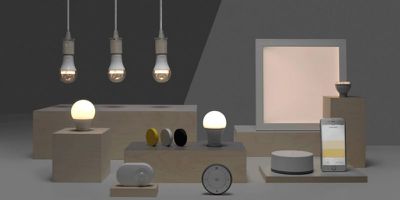Swedish home furniture store IKEA announced its own affordable smart lighting system today called Trådfri, which means "wireless" in Swedish.
The Smart Lighting range of products includes Trådfri LED bulbs, a remote dimmer switch puck, a gateway kit, a motion sensor kit, and dimming lights. IKEA is also introducing a selection of LED light panels and doors that can be built into cabinets for the bedroom and kitchen.

The Gateway starter kit will cost around $80 and includes two bulbs, a remote, and a gateway hub to connect everything to the app. The Trådfri bulbs have three white color temperature options (2200K, 2700K, and 4000K) that IKEA claims each last around 25,000 hours.
"The Ikea vision is to bring affordable home furnishing solutions to the many people. We know from research that existing smart lighting technology is perceived to be too expensive and difficult to understand, so we have worked to remove those barriers to make smart lighting more accessible," IKEA Home Furnishing expert Helen Longford said in a statement.
Like the Philips Hue series, IKEA's first range of automated lighting products is based on the ZigBee Light Link standard that got released in a number European countries late last year and should see a larger rollout at the end of this month.
IKEA gives a March 31 availability date for the lighting range in Sweden, with the range expected to arrive in the U.K in April, making them likely to roll out to other countries soon. The IKEA website makes no mention of compatibility with existing smart home platforms like Apple HomeKit, but support for other standards seems likely at some point down the line.
























Top Rated Comments
[doublepost=1490698781][/doublepost]Hey Siri (amongst other things)
I know some 5000K smart bulbs exist, but they're just too cool for me. And the Hue bulbs with a sliding scale temperature are too dim (500-600ish lumens, depending on the temp setting) and are twice the price. Hope this by chance works!
[doublepost=1490709117][/doublepost]Wow -- some real misconceptions here. For a product to support HomeKit in no way means other operating systems are locked out. They just don't have HomeKit. Nearly everything in my home is HomeKit compatible but also works just fine with any other operating system. Adding a feature doesn't necessarily mean you have to take others away, and it certainly doesn't with HomeKit.
Also, HomeKit does not require that "each and every device" have a special chip. Take Philips Hue, for example (a product that also supports my above point). Individual lights don't connect at all to HomeKit. Rather, they connect to the Hue bridge, which is HomeKit capable. That bridge manages the HomeKit integration and the security features (etc.). Case in point, I bought my entire Hue setup before Philips supported HomeKit. Once they added that support, I needed only to upgrade my bridge, at which point every light in my house became accessible via HomeKit.
[doublepost=1490709412][/doublepost]It probably doesn't to sell decently well, and Ikea may have made the right choice for their needs. But what you're hearing here is that many people really like what HomeKit has to offer and wouldn't welcome a "smart home" product into their own homes if it didn't offer HomeKit support. If you're not worried about device security (I doubt most people are) and just want lights that Alexa or whatever can turn on and off, then these should be fine. Many people here want more.